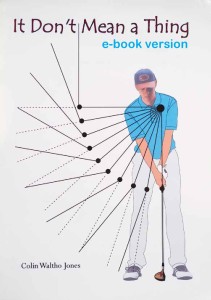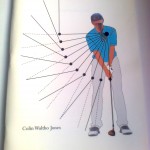“Get rid of that putter. Its gimmicks make you regard yourself as an inferior putter. Get yourself a Ping. They are a reasonable advance on the blade design, have stood the test of time and have the inestimable advantage of doubling up as a ball scoop! Rules of putting:
– NEVER bend down to assess the line: it is NOT how the brain works. …
– ALWAYS visualise the ball rolling into the hole. It is a fantastically strong image and will really excite your sub-conscious.
…
A “timed” putt will feel as if you are dragging the ball into the hole rather than hitting it at the hole. You can’t force this to happen, it is just a sign that you are starting to time the putts. A “timed” putt will roll differently; the ball will always look as if it is going at the right pace and as if it is “holding” its line.
——————————————————————————
[12. The 1967 Bell South Classic]
“Thank you for taking my coaching so seriously that you are willing to ditch the Starship Enterprise putter (I can’t wait to tell Luigi!). The reason for changing putter to a simpler design is so that you get used to the idea that it is you who is responsible for hitting good putts and so you don’t require any gimmicks to help you. There is absolutely nothing wrong with the putter, it just sends your psyche the wrong message.
—————————————————————————–
“The task facing a golfer standing over a putt isn’t quite what it is usually made out to be. This is how I see it.
Of all golf shots, the target of a putt – the hole – is the most specific. And because it is so specific, so the golfer is easily deceived into believing that the easily visible outcome of a putt (did the putt drop? how close did it finish? did it miss to the left or the right? etc) gives him useful information. But the outcome of the putt may not give him useful information; worse still, a lot of the information he believes he can deduce from the very visible outcome may be downright unhelpful, and may lead to all sorts of unnecessary and damaging adjustments to technique and equipment. Only on greens do you see technique and equipment that can best be described as eccentric. To balance this tendency to read too much into what the outcome of putts tells us, it is worth considering exactly what is happening when a putt is faced and then struck.
…
…
My view is that a golfer “sees” the line of most putts in the first few seconds of lining-up. This view comes from my own experience of playing golf and bowls and is in line with what is known to scientists about the strength of visual first impressions that humans use to make many, many judgements in life. Therefore, spending too much time lining-up will confuse matters for the golfer rather than help clarify them and is to be avoided. Also, time spent lining-up has the propensity to take time away from the much more difficult task of deciding on length, which is more difficult than lining-up because of the sheer number of “invisible” variables involved.
…
Given this context, then, a well-timed putt (and the golfer will know whether it has been “timed” or not) that ends up close to the hole is a successful putt and should be viewed as such because the golfer has chosen a sufficiently correct line and length and has “timed” the putt. A well-timed putt that ends up dropping into the hole should be viewed as a “lucky” version of the successful putt described above because it is a matter of luck that precisely the correct combination of line and length has been chosen and found. A well-timed putt that ends up on the lip is a successful putt that lacked a little bit of luck.
My advice is to NEVER, NEVER tap in. If you think about the “maths” of putts more than 4 or 5 inches from the hole then the propensity for missing them is huge. Stand over the putt, see the ball drop into the hole, take a deep breath, let the putter swing back and forth. Nothing else is worth risking.
————————————————————————
(Just to nit pick for a minute. You write: “The 2nd was playing extremely difficult – good drive followed by a 3 iron to the right, a good chip but missed the putt from about 5’ so a 5.”
As I mentioned in the last reply you need to be very careful not to put too much strain on the expectations of your putting. A better description would have been: “I get a shot on the difficult 2nd. I hit a good drive, a good 3-iron and a very nice chip to 5′. I took the regulation two putts for a safe and, given the 6 on the first hole, a very pleasing 5.”)
“The 3-putt on the third is disappointing, but at least your description is good! The point to ponder here is . . .
———————————————————————-
[15. Faults will fix themselves]
Putting in difficult conditions – The danger to your score presented by adverse conditions comes in the form of the fact that your conscious brain will delight in using the excuse of adverse conditions to take over from your sub-conscious the process of hitting putts.
In your e-mail you use phrases such as: “the greens were disappointing”, “they hadn’t been cut”, “all different speeds depending on how recently they had been hollow tined”, “a number of players were unhappy”, “to give you some idea of putting into the wind”, “I have no idea how much it will affect the ball”, “I aim for the left lip but the ball just goes straight in the wind”, “ and because the greens were slow you had to hit the putts to get them up to the hole which I didn’t do”, “Possibly my 3 putt on the 2nd put me off a bit. I hit it pretty hard because it was uphill and into the wind and it went 5’ past.”
All these comments are undoubtedly true, and completely unhelpful. They are unhelpful because they are
————————————————————————
“Boxing Day – It is really very pleasing how you are holding your form. Playing to 2 is very encouraging despite the 35 putts. If you remember, I wrote that putting was a two-shot gig: single putts were flukes and 3-putts were abominations (I heard recently that Luke Donald at some point this year had played over 400 holes without 3-putting!). In that context, 35 putts is average and does not match your verdict of: “… but my putting was poor.” Playing to 2 when you have hit 35 putts means that you must be a 2-handicapper and therefore quite capable of going lower with a good putting round.
Three-footers
When you miss from 3’ it is easy to be disappointed and the disappointment will tempt you to start to look for all sorts of reasons why you are missing short putts. But 3’ putts are not easy, they just look easy. Consider that the pressure on them is greater than other shots because they are the shot that finishes the hole and determines the outcome. They have to be hit with perfect “timing” even though the swing used to hit them is tiny because the force required is small. If the “timing” is less than perfect then there will be an element of mis-cueing and often as a result the ball can roll agonisingly past the hole. Also, the putt is 3’ away because of the previous putt. If the 3’ is a result of a poorly “timed” approach putt, then the pressure on the stroke increases as your confidence in being able to locate your “timing” ebbs a little.
My advice would be to never . . .
————————————————————————————–
However, even after a thumping first drive there is a problem with first putts on unfamiliar greens, which is that you don’t have any idea how hard to hit them. This lack of certainty is a distraction to your subconscious and likely to affect your timing; and timing a putt is the most difficult timing of all because the amount of force that needs to be delivered is so small and so precise, especially as compared to a full blooded drive on to a green. So, what’s the answer?
The answer is to pick up as many clues as you can about the speed of the green – how it looks, dryness/wetness, local opinion; absorb what you can about the speed and line of the putt i.e. slopiness; then fight against the natural urge to want a definite answer to the conscious question “how hard am I going to have to hit this?” This urge will have an element of embarrassment avoidance about it because you are in unfamiliar surroundings with unfamiliar people whom it would be quite nice to impress. It is a moment when you need to have confidence in your technique, and by that I mean the technique of virtually guaranteeing timing on every shot. I think this is an answer because I believe that a well timed putt fed by fully absorbed information about conditions will go close enough to at least satisfy embarrassment avoidance needs.
Having found your timing with a drive on to the green you are well placed to . . .
—————————————————————————-
Let’s talk about the putting then. My advice is to read over my stuff about putting and ask yourself if you can honestly say that you rigourously followed the method on all those short putts that have left you so frustrated. The point behind this is so that you end up taking responsibility for the performance rather than simply blaming your poor long-suffering putter.
Those putts from 3’ and 4’ are the most difficult shots you face on a golf course because the target is relatively the smallest you have to hit, and the penalty for missing is relatively the biggest. However, in your favour is the fact that the number of possible solutions – line and speed combination – is much reduced by the close proximity of the hole. Therefore, it is more likely that you are going to be able to find one of the solutions with your strike. What will stop you finding a solution is the absence of perfect “timing”, and what will cause your “timing” to go missing is muscle tightness brought on by the pressure to hole out. That’s why strict adherence to the method is critical because it maximises your chances of locating your “timing” by using the pressure of the situation to make your conscious mind give better visualisation information to your subconscious.
This is what you need to take from the tournament. You need to “get” that pressure is a . . .


